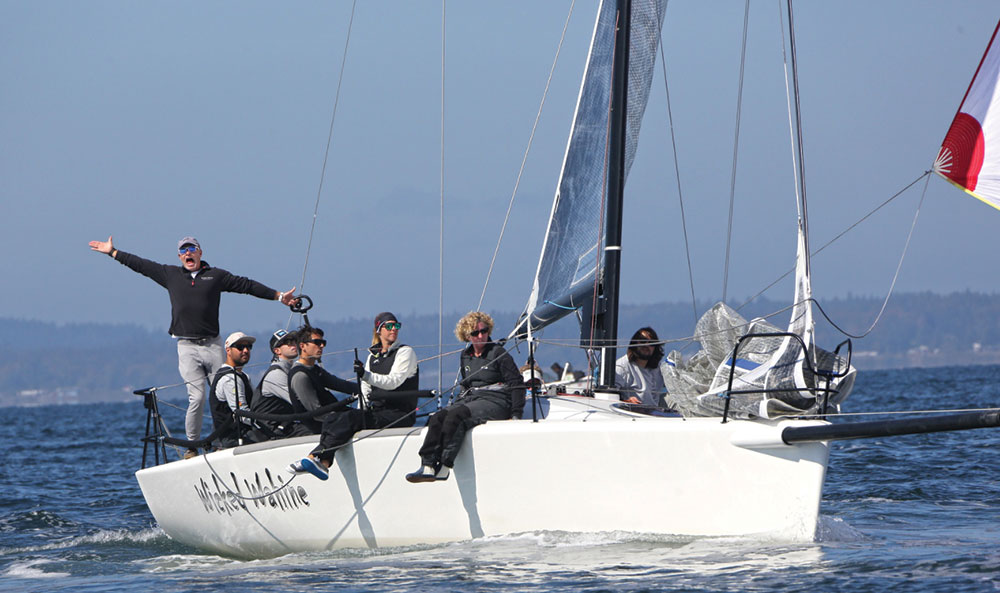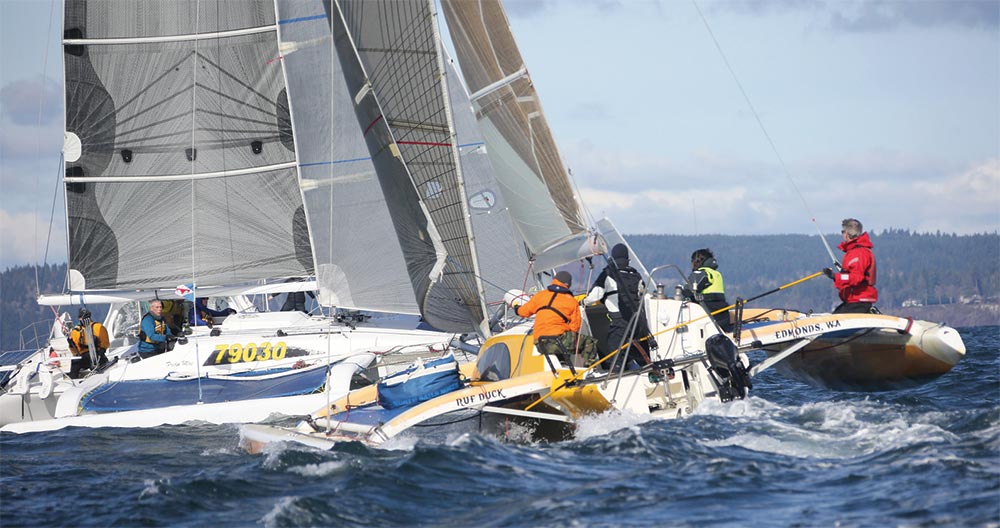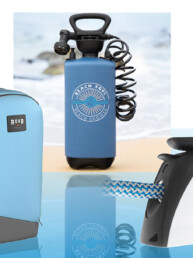From the March issue of 48° North.
Racing Rules about Hailing Another Boat
There are many misconceptions regarding the requirements for hailing another boat during a sailboat race. Let’s try to simplify things a bit and provide some practical rules and tips.
Only two of the Racing Rules of Sailing (RRS) require a hail: 20 and 61.1(a). We’ll address them in reverse order.
RRS 61.1(a) is “in the sixties,” so you know it has something to do with protests or redress. It is the requirement that you hail the word “Protest” to the other boat(s), “at the first reasonable opportunity” following “an incident in the racing area.” Note that you must use the word “Protest.” Yelling “do your turns” or “you fouled me” or other words to that effect, without the word “Protest” does not meet the requirement of the rule.
The only exception to this is when the boat being protested is beyond hailing distance. In that case, while you don’t need to hail, you still need to inform the other boat “at the first reasonable opportunity.” Just filing the protest is not sufficient. You need to seek out the other party(ies) and let them know you are protesting.
And if someone hails “protest” at you, there is no requirement for a return hail. If you think you may have broken a rule, your obligation under the rules is to take the appropriate penalty. If you don’t think you may have broken a rule, no response is needed. In other words, keep it civil.
RRS 20 gives the requirements for when you need room to tack at an obstruction. You must be sailing close hauled or above to invoke this rule (RRS 20.1(b)). You also can’t use it on a boat that is fetching the next mark (which usually only happens when sailing a marks-to-starboard course).
Note there are no provisions for obtaining room to jibe at an obstruction. When the boats are sailing downwind, RRS 19 applies.

Unlike RRS 61.1(a), RRS 20.1 does not provide specific words to use when hailing for room to tack. But it does include a couple of important requirements with respect to the hail. First, the hail must be made early enough to give the hailed boat time to respond (RRS 20.2(a)). Further, if the boat you are hailing needs to hail another boat, and they need to hail another boat (and so on), you need to allow time for the hails to proceed all the way up the chain (RRS 20.3). This is critical, so think ahead and don’t expect that you will get room to tack when you hail only seconds before you would have a collision.
RRS 20.4 is a new rule for 2021-24 and adds another requirement; if you’re sailing in conditions where your hail may not be heard, you must also make a signal that clearly indicates you need to tack. This usually means an arm gesture such as repeatedly pointing to windward. The Notice of Race can prescribe specific means of alternate communication in this instance — usually a specific hand signal. But other signals can be used for specific types of boats, e.g., radio call when sailing very large boats.
Also unlike RRS 61, RRS 20 requires one of two specific responses if you are hailed for room to tack:
Tack “as soon as possible.” Note it does not say “immediately.” This is to allow the hailed boat to hail the next boat to windward (and so on), if that applies.
Immediately replying “you tack”. (Note: specific words to use are prescribed). You must then give the other boat room to tack and continue to avoid her until the boats are clear of each other.
Note that doing nothing or hailing back “you can’t call for room now” or something to that effect is not an option. Even if the hail for room to tack was made when the hailing boat does not meet the requirements of RRS 20.1, you still have to respond with either a quick tack (or hail up the chain) or a hail of “you tack” per RRS 20.2(b). Of course you can (and probably should) add the word “Protest” and fly your protest flag immediately after responding as required when the hail was made by a boat not meeting the requirements of RRS 20.1.
But we’re not done with RRS 20 yet. If you are the hailing boat, as soon as the other boat tacks or hails “you tack,” you must then tack “as soon as possible” (RRS 20.2(d)). You can’t wait a few more seconds so you have a clear lane or until you get to the layline. You need to tack right away.
The only other provision with respect to hailing in the RRS is in the Introduction. It allows use of languages other than English for hailing if that would reasonably be understood by all the other boats. But hailing in English is always acceptable. So if you’re competing in a regatta in Mexico, you don’t need to learn Spanish. And people whose native language is not English only need to learn three words of English (“protest” and “you tack”) plus whatever phrase they want to use to request room to tack.

But what about all those other hails we hear out there every race? “Starboard!” “Hold your course.” “Can I cross?” “You hit the mark. Do your turn!” “Come up! Come up!” And even, “*&^#%$!”
They don’t mean anything with respect to the racing rules — except that “*&^#%$!” can get you protested for misconduct. They are, for the most part, intended as a courtesy to the other boats. For the most part, I ignore them and don’t respond. The only exception is when you get a hail of “Tack or cross?” I usually reply, “Your call.”
With respect to all those hails of “Starboard!” I think most are unnecessary and distracting. If someone on the port tack boat is on the low side and looking right at me, no hail. I only hail when I am convinced the port tack boat doesn’t know I am there. And I try to do so in a manner that gives them plenty of time to overcome any surprise and tack or duck in a safe manner.
Finally, as I have become more experienced and do a better job of keeping an eye out for other boats, I am proud to say it is quite rare for a call of “Starboard!” to surprise me or my tactician. I think that is a good goal for every sailor to have.
Photos by Jan Anderson.






